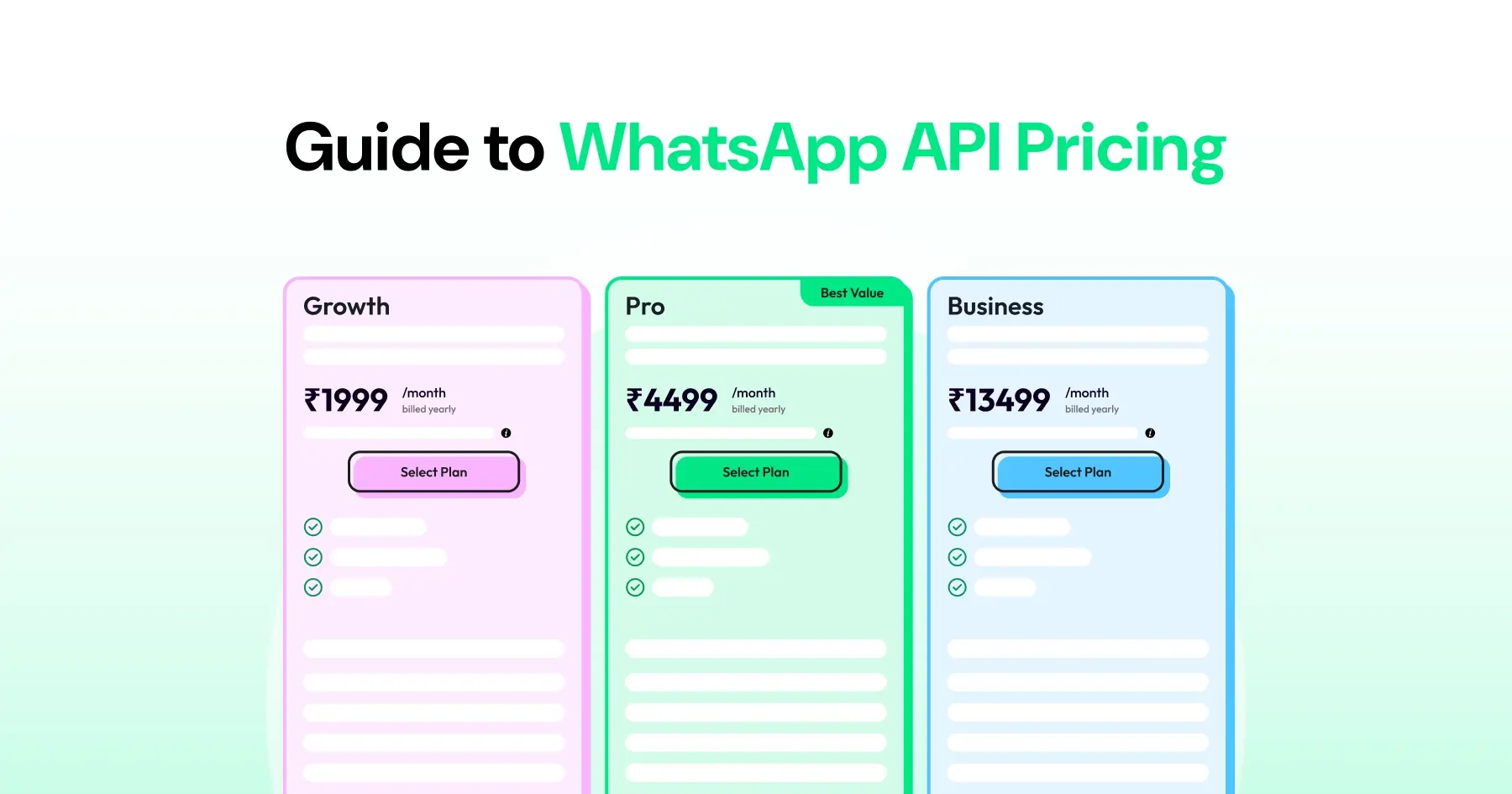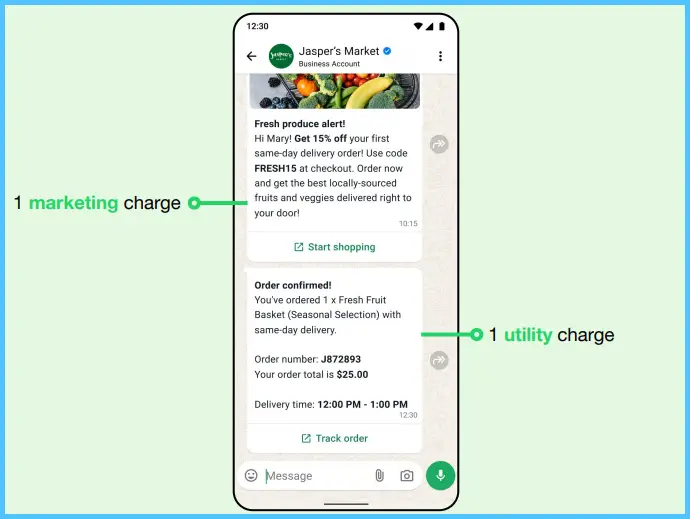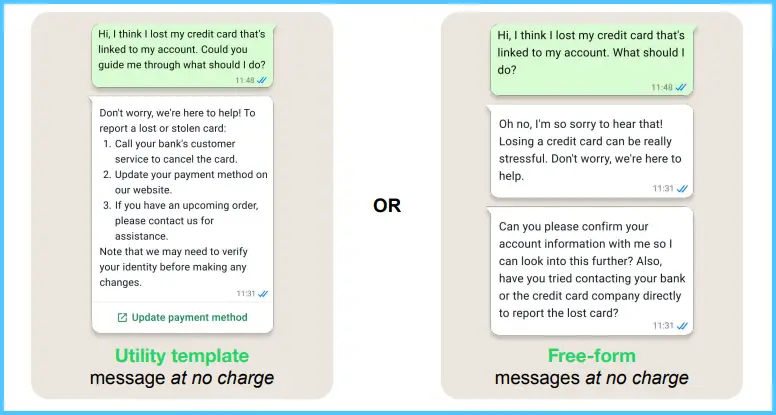
How the WhatsApp API Pricing Change Impacts Your Messaging Strategy?
Written by:
 Ashwin
|
on:
March 29, 2023
|
Last updated on:
November 5, 2025
|
Fact Checked by :
Ashwin
|
on:
March 29, 2023
|
Last updated on:
November 5, 2025
|
Fact Checked by :
 Namitha
|
According to: Editorial Policies
Namitha
|
According to: Editorial Policies
Too Long? Read This First
- WhatsApp Business Platform pricing shifted to per-message billing instead of per conversation window.
- Marketing templates are always charged per delivery; Utility templates are free only inside the 24-hour customer service window; Authentication templates are chargeable.
- Free-form replies within the 24-hour customer service window remain free, as long as the user initiates the conversation.
- Volume tiers apply to Utility and Authentication messages, unlocking lower per-message costs as you scale.
Meta has announced significant changes to the WhatsApp API Pricing, effective July 2025. Instead of paying per conversation window, businesses will now be billed per template message delivered.
To understand how this affects costs, it helps to first look at how the WhatsApp Business Platform pricing model is structured.
What is the WhatsApp Business Platform API Pricing Model?
The WhatsApp Business Platform (often called the WhatsApp Business API) enables businesses to send messages (templates, notifications, customer service replies) via the Meta ecosystem.
The WhatsApp API pricing is determined by a few factors:
- The message category (marketing, utility, or authentication)
- The destination country of the recipient
- Whether the message is sent within an active customer service window
In effect, you don’t just pay a flat monthly fee; you pay for delivered template messages (in most cases), and some messages may be free under specific conditions.
This model is especially relevant for brands and agencies using WhatsApp as a channel for outreach, notifications, or support.
Key Changes to WhatsApp API Pricing (Effective 1 July 2025)
Pricing is Now on a Per-Message Basis
WhatsApp now charges businesses for each template message sent, instead of billing by conversation windows. This is one of the most important updates in the WhatsApp Business API pricing structure.

So, if you send one marketing template and one utility template, each will be charged separately.
Template Message Types
- Marketing: Templates that promote offers, discounts, cart reminders, product launches, re-engagement, etc. This is business-initiated, promotional in nature. Under the new WhatsApp API pricing model, these are charged per message.
- Utility: Templates that provide non-promotional, user-action-triggered information: e.g., order confirmations, shipping updates, appointment reminders, payment receipts. Under the new model: free if sent within the open service window; charged if outside.
- Authentication: Templates used for login/OTP/verification (one-time codes, etc). Under the new WhatsApp Business API pricing model, these are also charged per message.
- Free-form support replies (non-template): Allowed only inside the service window; they are free (no charge). Outside the window, you cannot send free-form; you must use a template, which is billed.
| Note: The actual per-message rate depends on the recipient’s country (not necessarily the sender’s country) and message category. |
Free Responses with Customer Service Window
Businesses can send free-form messages at no cost within the 24-hour customer service window. This window starts every time a customer sends a message and resets with each new one.

As long as the window is open, businesses can reply without paying, but only with free-form messages (not templates).
| What is a Customer Service Window? The “customer service window” (also called the 24-hour support window) refers to the period during which a business can freely exchange non-template (free-form) messages with a user after the user has initiated a chat. |
How Does a Customer Service Window Work?
– User sends a message to your business > the 24-hour timer begins.
– Within that window, you can send free-form replies (not pre-approved templates), and you may send utility templates free of charge.
– Outside of the 24-hour service window, any business-initiated message must use a pre-approved template and will be charged under the WhatsApp API Pricing 2025 rules.
Utility Templates Are Free Inside the Service Window
Apart from free-form replies, Businesses can now send utility template messages free of cost within the 24-hour customer service window.

This gives more flexibility to share essential updates (like order confirmations or appointment reminders) without incurring additional costs.
Volume Tiers Unlock Cheaper Pricing
For utility and authentication templates, WhatsApp now offers tier-based discounts.
As businesses grow and send more messages in a specific category and market, you can unlock lower per-message rates. This rewards higher usage with better pricing and makes the WhatsApp Business API pricing structure more scalable for enterprises.
Tier-Based Pricing on WhatsApp Business Platform
| What is it? | Meta offers volume-based pricing tiers for Utility and Authentication messages. The more messages you send in these categories, the lower your per-message cost. |
| How does it work? | Tiers apply at the market + message category level (for example, “India – Utility”). As you move into higher tiers within a month, only the messages above that threshold are billed at the reduced rate. |
| What’s excluded? | Marketing templates are not eligible for volume discounts. Free-form and free-in-window utility messages do not count toward tier volume since they are not billed. |
| Why does it matter? | Businesses with higher volumes of transactional or authentication traffic can save significantly once they cross tier thresholds, making large-scale messaging more cost-efficient. |
Free Entry Points Extend the Value
When a customer reaches a business via a Click-to-WhatsApp ad or a Facebook Page button, WhatsApp gives a 72-hour free entry point window.

During this period, template messages are free, as long as businesses reply within the usual 24-hour customer service window. This offers extra value for businesses running ads or using Facebook entry points to drive chats.
Understanding the WhatsApp API Pricing Change With an Example
Let’s take the example of Jasper’s Market, a business using WhatsApp to connect with customers.

- The business sends a promotional message: “Fresh produce alert! Get 15% off your first same-day delivery order.” Since this is a marketing template, it is always charged per message delivered.
- The business follows up with an order confirmation: “Order confirmed! Delivery between 12:00 PM – 1:00 PM.” Utility templates sent outside a customer-initiated message window are chargeable.
- Later, they notify the customer about a delivery delay: “There’s been a delay. Can you confirm if you’ll be home between 5–7 PM?” This is also a utility template, and it is billed per message.
- The customer replies: “Yes, that time works!” Jasper’s Market responds: “Thank you so much for your understanding.” Because this reply is a free-form message sent within the 24-hour service window, it incurs no charge.
- Finally, the business sends a verification message: “Please use code 877998 to receive your package from our courier.” Authentication templates are always billed, regardless of timing.
Why has Meta changed the WhatsApp API pricing model again?
Several reasons underpin this change:
Simplification & Transparency
The old conversation-based model was often confusing (which message triggered a charge? what type of conversation? what category?). The new per-message model gives businesses clearer cost visibility.
Prevent Abuse of Categories
With clearer definitions and stricter enforcement (especially of the distinction between utility and marketing), the system is less susceptible to misuse (e.g., disguising promotional messages as “utility”).
Scalability & Volume Economics
With volume-based tiers and per-message billing, Meta can scale its messaging ecosystem more predictably and support high-volume enterprise use cases.
Revenue Model Clarity
A per-message billing strategy ensures that each business-initiated interaction has a cost traceable to it, which supports budget planning, ROI measurement, and aligns with WhatsApp’s business ecosystem monetization.
Why This Matters for Wati Users?
- You’ll now need to budget per template message instead of per conversation.
- To reduce costs, design flows in Wati that encourage customers to message first, so you can send free utility updates inside the 24-hour window.
- Review automations carefully: any template sent outside the window (utility or marketing) will be charged.
- Keep an eye on volume tiers in Wati’s analytics. Higher usage of utility/authentication templates could move you into lower per-message pricing brackets.
- If you run Click-to-WhatsApp ads, link them directly to Wati to take advantage of the 72-hour free entry window for more value.
Closing Thoughts
The July 2025 WhatsApp Business pricing update is more than a change in cost structure. It is an opportunity for Wati users to rethink how they engage with customers on WhatsApp.
By being intentional about when and how templates are sent, businesses can control spend while still keeping conversations personal and timely. The real win lies in balancing efficiency with customer experience.
Take the next step in your WhatsApp messaging strategy and align it with the new pricing model to stay ahead of the change.
Frequently Asked Questions
As of July 1, 2025, businesses are charged for each delivered template message, rather than paying a flat fee per conversation window.
Yes. Free-form replies (non-template messages) sent within the 24-hour customer service window after a user-initiated chat are free. Additionally, utility templates sent within that same window may incur no charge.
It is a period of 24 hours that begins when a user sends a message to your business. During this window, businesses can send free-form replies and may send utility templates at no charge. After that window closes, messages must use approved templates and will be billed.
Volume tiers apply to utility and authentication messages. As businesses send more messages in a given market category (for example, “India-utility”), they automatically unlock lower per-message rates.
The pricing rate is determined by the recipient’s country (market) and message category. The per-message cost varies significantly by destination market.



Good post! We will be linking to this particularly great post on our site. Keep up the great writing
Thank you